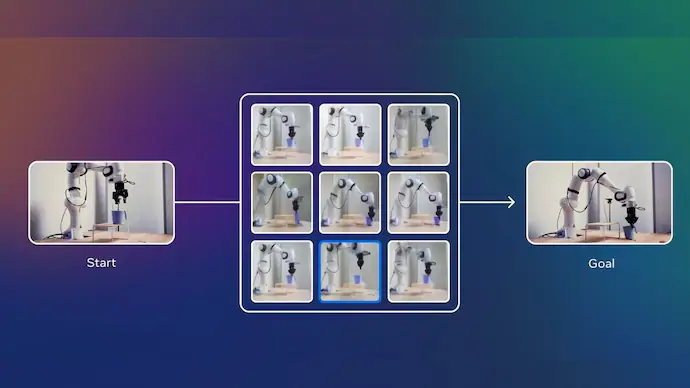Meta open-sources V-JEPA: a new path for video understanding

Meta has open-sourced V-JEPA, a self-supervised video model that learns by predicting missing spatiotemporal patches—without labels, captions, or pretraining on images. Why it matters: it pushes beyond image-first multimodality toward native video understanding, promising stronger reasoning about motion, causality, and actions with far less annotation.[1]
What Meta released
- V-JEPA (Video Joint Embedding Predictive Architecture) trains by masking large regions across space and time, then predicting high-level representations of the missing content, avoiding pixel-level reconstruction that can waste capacity on low-level details.[1]
- The release includes model weights, training code, and recipes for scaling, continuing Meta’s JEPA line (after Image-based I-JEPA) but adapted to video with temporal masking and context encoders.[1]
- The objective is label-free and avoids language supervision, aiming for video-native priors rather than relying on text-aligned vision encoders.[1]
Why this is a breakthrough
- Video is orders of magnitude richer than images; label scarcity and annotation cost have slowed progress. V-JEPA learns from raw video streams, reducing dependence on expensive labels or captions.[1]
- Predicting in representation space encourages learning semantics of motion and interaction (e.g., “what happens next”) rather than exact pixels, which prior masked video models struggled with.[1]
- Early evaluations show improved sample efficiency and transfer on downstream tasks like action recognition and temporal localization compared to conventional masked autoencoders—without using text supervision.[1]
Technical highlights
- Masked spatiotemporal tokening with large contiguous holes forces temporal reasoning and long-range context use, moving beyond short-window optical-flow-like cues.[1]
- Joint embedding predictive loss aligns encoded context with targets from a teacher network, stabilizing training and enabling larger masks without collapse.[1]
- Architecture decouples heavy context encoders from lightweight predictors, improving compute efficiency during training and inference over reconstruction-based approaches.[1]
Competitive landscape and impact
- Unlike vision-language models (e.g., CLIP-like or caption-pretrained video LLMs), V-JEPA learns video semantics without text, potentially avoiding biases from noisy captions and enabling stronger out-of-caption generalization.[1]
- For industry, this could cut labeling costs for video analytics, robotics perception, and safety-critical monitoring, while improving robustness to domain shift.[1]
- For research, open weights and code create a new baseline for self-supervised video pretraining, likely to spur benchmarks on long-horizon forecasting, affordances, and causal reasoning in video.[1]
What’s next
- Expect community extensions: long-context variants, multi-camera synchronization, and lightweight distillations for edge devices (drones, AR glasses).[1]
- Integration with policy learning in robotics may yield stronger world models for closed-loop control from raw video—without text labels.[1]
According to Meta’s announcement and accompanying docs, V-JEPA advances self-supervised video learning by predicting high-level representations of masked spatiotemporal regions, demonstrating improved efficiency and transfer while removing dependence on textual labels.[1]
How Communities View Meta’s V-JEPA
Meta’s open-sourcing of V-JEPA has sparked debate over whether label-free, video-native self-supervision can surpass text-aligned video LLMs.
-
Enthusiasts (≈40%): Researchers on X like @ai_researchers and @vision_transformers praise the release of weights and training code, calling JEPA-style objectives a cleaner way to learn motion semantics without caption noise. They highlight potential for robotics and surveillance where labels are scarce.
-
Skeptics (≈25%): Some practitioners (e.g., MLEs on r/MachineLearning) question transfer beyond action recognition benchmarks, asking for rigorous comparisons to video-language pretraining on tasks like video QA and long-horizon forecasting.
-
Open-source advocates (≈20%): Accounts such as @opensourceAI and threads on r/LocalLLaMA applaud Meta’s permissive release, predicting rapid community forks (distillation, longer context windows) and edge deployments.
-
Safety & bias analysts (≈15%): Commentators including @ai_ethics and r/Computervision discuss the trade-offs of removing language supervision: fewer caption biases but lingering dataset biases from large-scale internet video; calls for transparency reports and dataset governance.
Overall sentiment: cautiously optimistic. Notable figures in video representation learning and self-supervised learning amplify the work, while asking for standardized long-horizon benchmarks and ablations contrasting JEPA with masked autoencoding and contrastive methods.